
December 2017
Toward a Multiracial Revolutionary Party
Imperialist Social Democracy
vs. Black Liberation
By R. Titta
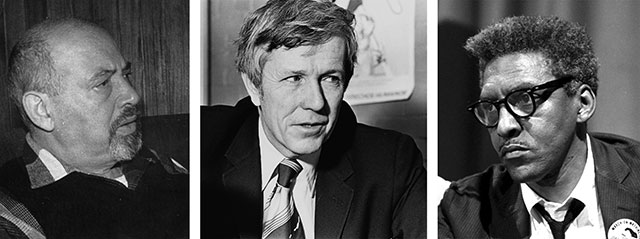
Rogues’ gallery of Shachtmanism: acting on behalf of U.S. imperialism in sabotaging struggle for black liberation. From left, Max Shachtman, Michael Harrington and Bayard Rustin in the 1960s.
(Photos (from left): marxist.com; Warren Leffler/Library of Congress; Barbara Alper/Getty Images)
In the 1950s during the anti-Soviet Cold War – and especially as it was playing out in Africa – Southern racism was becoming an embarrassment to U.S. imperialism. The British empire was threatened by anticolonial movements but also by U.S. imperialism, which was demanding entry into all the markets formerly dominated by Britain and other European powers. The U.S. imperialists preferred, where they could, to rule using local dictatorships, rather than direct occupation. The U.S.’ “neocolonial” model was the Latin American “banana republic,” as they disparagingly called countries ruled by brutal military dictatorships that gave a free hand to U.S. corporations like the United Fruit Company (“Chiquita”), Kennecott Copper, Standard Oil, and ITT.
The U.S. looked at Africa and saw a giant treasure-trove of gold, diamonds and jewels of all kinds, rare minerals including uranium and cobalt, petroleum, coffee, cocoa, and what have you – potentially commodities worth many billions then (in the trillions today). But African peoples were rising up against the old colonialism, inspired by the war of the FLN (National Liberation Front) against the French in Algeria and the Mau-Mau uprising against the British in Kenya. At the same time, the U.S. imperialists, mouthing slogans of “democracy,” were losing battles for African “hearts and minds” to the Soviet Union.
As the civil rights movement picked up in the U.S. South, images were flashed around the world of Ku Klux Klan night riders and fat cops with fire-hoses and German shepherd dogs loosed on black marchers, many of them children. The ugly reality of U.S. “democracy” was there for all to see, undercutting Washington’s effort to counterpose itself to British colonialism and what the imperialists saw as the Soviet “Communist threat.” The brutal American segregation system known as Jim Crow was seen by the U.S. imperialists as a public relations problem. The American “social democrats,” dominated by followers of one Max Shachtman, believed they had a plan to solve it. They called it “realignment.”
Imperialism’s Fake-Socialist Servants: Whose “Southern Strategy”?
Max Shachtman was a renegade from Trotskyism who became a crusading anti-Communist and eventually an ardent defender of U.S. imperialism. The most prominent Shachtmanite leaders were Michael Harrington and Bayard Rustin. They were then running the U.S. Socialist Party, which was still formally headed by aging CIA “asset” Norman Thomas. (Yes, the formal head of the Socialist Party was a State Department propagandist who worked with and took the spy agency’s money.)
Like the young, idealistic black militants of the civil rights movement before them, today’s opponents of America’s racist system of capitalist oppression must learn some hard lessons about how it functions. First of all, the Democratic Party – from Barack Obama and Bill Clinton to Bernie Sanders and Elizabeth Warren – is a bulwark of U.S. imperialism and the most dangerous enemy of all the world’s workers, black, brown, Asian, and white. Second, many who call themselves “socialist” are sworn enemies of socialism: they are or aspire to be duplicitous agents for the Democrats and the capitalist bosses. Latter-day Shachtmanite-like fake socialists include, most prominently, the anti-socialist International Socialist Organization (ISO) and the Democratic Socialists of America (DSA).
So back to “realignment.” Shachtman devised his plan with a close collaborator, Robert M. Martinson, and attempted to carry it forward with Harrington and Rustin. Shachtman understood that the Democrats were the dominant party of U.S. imperialism but could fall from power without the support of the KKK and the White Citizens’ Councils (the chamber-of-commerce bosses of the Klan). If the Southern racists left the Democratic Party, the balance of power in the U.S. would tip to the more isolationist Republican Party. To ensure the “American Century,” as the U.S. imperialists called their world domination, Shachtman proposed that the Democrats shift their alliances to line up with the Southern black population and the anti-Communist labor bureaucracy.
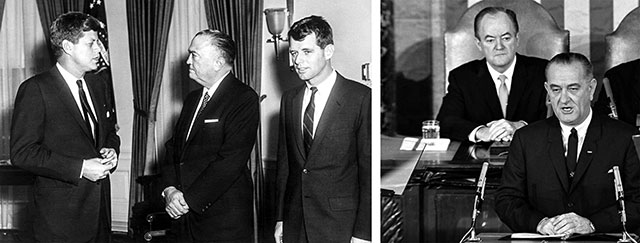
The Shachtmanites’ masters: (Left) President John F. Kennedy with FBI chief J. Edgar Hoover and Attorney General Robert Kennedy. (Right) President Lyndon Johnson and Vice President Hubert Humphrey behind him.
(Photos (from left): Abbie Rowe/National Park Service; AP)
Shachtman did not act to put his plan into operation immediately, since political considerations over the election of Lyndon Johnson (LBJ) in 1964 caused the Shachtmanites to continue to support the retention of the Southern racists in the Democratic Party. “Realignment” did occur some years later, but in a rather different way. As black voting became more possible, the Republicans under Nixon courted the Southern racist vote. This caused a split in the Shachtmanites, with Shachtman and his tendency in the Socialist Party supporting Nixon in 1972 and then changing the SP’s name to Social Democrats USA (SDUSA), while Harrington founded the “Democratic Socialist Organizing Committee” (DSOC, forerunner of the Democratic Socialists of America) to continue supporting the Democrats.
Today we take it for granted that the white racist vote in the South (and across the U.S.) is mainly or all Republican, while black people who are allowed to vote (millions have been disenfranchised) generally vote Democratic. But this pattern contrasts sharply with the status quo during the civil rights movement. At that time the Democratic Party was the party of the KKK and Jim Crow, as it had been since the days when it organized racist terror in resisting Republican-led Reconstruction after the Civil War. Now, even Klansman David Duke runs in the Republican, not the Democratic primaries. At the same time, since the days of Roosevelt’s “New Deal Coalition,” the union bureaucracy became more and more deeply enmeshed in the Democratic Party apparatus. Nixon’s role in getting the former “Dixiecrats” – Southern white racist politicians – to switch to the Republican Party is sometimes referred to as the “Southern Strategy.”
After Democratic president Johnson signed the Voting Rights Act in 1965, formally upholding voting rights for blacks in the South that had been suppressed since the defeat of Reconstruction in 1876, right-wing Republicans saw the chance to capture millions of racist votes. They would campaign in the South using code words like “states’ rights,” “traditional values” and “law and order.” Even the linguistically challenged KKK and their followers got the idea. The strategy was nearly derailed in 1968, when Alabama’s Democratic governor George Wallace (whose slogan was “Segregation Forever”) ran as the candidate of a KKK-style third party and gained most of the Southern states’ electoral votes. Nixon won the election anyway, running against Hubert Humphrey, Johnson’s widely hated vice president, who became the Democratic candidate after LBJ dropped out of the race as it became clear the U.S. was losing the Vietnam War.
Ever since those days, Republican campaigners have upped the racist rhetoric in the South. Reagan began his campaign for president in 1980 proclaiming “I believe in states’ rights,” in a speech delivered near Philadelphia, Mississippi – where the KKK and police murdered heroic civil rights workers James Chaney, Andrew Goodman and Michael Schwerner during Freedom Summer in 1964. The message got across.
SNCC and the Radical Black Challenge to Jim Crow Racism
The Student Nonviolent Coordinating Committee (SNCC) emerged in 1960 amid the sit-in movement to integrate lunch counters throughout the South. Comprised mainly of Southern black youth, SNCC was initially tied to Martin Luther King’s Southern Christian Leadership Conference (SCLC). Beginning in 1955, with Rosa Parks’ refusal to surrender her bus seat to a white passenger in Montgomery, Alabama, the civil rights movement posed a high-profile challenge to the violent, reactionary American political regime of the 1950s. Black people took the lead in the most extensive social movement since the 1930s. SNCC became a courageous expression of youthful black defiance of Jim Crow and McCarthyism.
The official civil rights leadership under King wanted to limit the struggle to peaceful protest and moderate reforms, but the racist power structure of U.S. capitalism reacted with extreme violence to the slightest democratic demands. When King’s SCLC attempted to impose its conservatizing will on SNCC, the results were mixed. For a time, SNCC was split between a more conservative wing wanting to focus on voter registration and a more radical wing seeking direct action: the integration of public facilities such as swimming pools and lunch counters. In practice, as SNCC leader James Forman argues in his book The Making of Black Revolutionaries (1985), radicalism could not be avoided, since “the establishment” treated all civil rights activity as a mortal threat to its power.
At the highest levels, U.S. capitalist rulers recognized and feared the revolutionary potential of an organization of black youth fighting for black freedom in the South. While “nonviolent” was part of SNCC’s name, many of its militants came to advocate self-defense against racist terror. As a SNCC leader, Forman joined Robert F. Williams in Monroe, North Carolina, in 1961. Williams had been head of the local NAACP when in 1957 he decided to fight back against deadly Klan and police violence. He and wife Mabel Williams organized a black branch of the National Rifle Association. (See “Who Controls the Guns?” The Internationalist No. 34, March-April 2013.)
This became an armed self-defense guard of black volunteers, mostly army veterans. Their militant and disciplined actions routed Klan night riders, driving these scum out of black neighborhoods. The Native American Lumbee tribe of North Carolina found Williams’ example inspiring. In a compelling demonstration of the power of militant leadership in fighting racist terror, the Lumbee smashed a planned Klan attack. Hundreds of Lumbee people, armed and determined, suddenly advanced as the Klan gathered. The Native Americans sent the Klan scum scuttling into the swamps where they belong. This was the “Battle of Hayes Pond” on 18 January 1958.
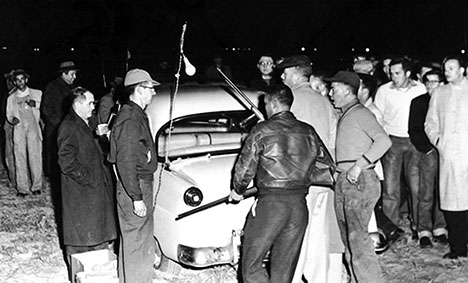 Armed members of Native American Lumbee tribe
(right) drive off KKK night riders in Battle of Hayes Pond, 18
January 1958.
Armed members of Native American Lumbee tribe
(right) drive off KKK night riders in Battle of Hayes Pond, 18
January 1958. (Photo: Fayetteville Observer)
Forman was present with Williams in Monroe as they tried to defend Freedom Riders from the North who were attempting to integrate interstate bus travel. The white racists rioted and Forman was nearly killed. Robert and Mabel Williams had to flee to Cuba following the revolution there, where they established “Radio Free Dixie,” broadcasting music and political commentary from Havana. Forman’s experience with Williams raised the level of his militancy. Like many in SNCC he was beginning to understand that revolutionary struggle would be needed to defeat racial oppression in America. However, as black youth put their bodies on the line – as they were arrested, convicted of serious crimes, spied on by the feds, beaten, shot at and lynched – Northern Democrats and labor bureaucrats sought to infiltrate, co-opt and squelch the struggle.
With the election of John F. Kennedy as president in 1960, the SCLC leadership committed itself to working within the Democratic Party, the party of Jim Crow segregation and the KKK. But the Democrats had become concerned about the “threat” of radical black militancy. The U.S. government also sent its operatives to infest SNCC meetings, including future liberal congressman Allard Lowenstein, whose far-ranging work with the CIA has been extensively documented. 1 Robert Kennedy had been a counsel for anti-communist witch-hunting senator Joseph McCarthy in the early 1950s and later chief counsel of the anti-labor McClellan Committee. As U.S. attorney general from 1961 to 1964, RFK promised money and, reportedly, draft deferments if SNCC leaders would desist from direct action and focus on voter registration in designated areas.
The “Liberal-Labor Syndrome”
Enter the professional anti-communist Shachtmanites and the Socialist Party.
James Forman described the forces arrayed against SNCC as the “liberal-labor syndrome,” because they comprised Democratic politicians, government agents and union bureaucrats. He explained:
“[Lowenstein] represented a whole body of influential forces seeking to prevent SNCC from becoming too radical and to bring it under control of what I have called the liberal-labor syndrome....
“The liberal-labor syndrome...was typified by its close links with the Kennedy administration and later to liberal Democratic elements in the Johnson administration, by the influence of Walter Reuther of the United Automobile Workers, by its violent Red-baiting, and by its social democratic line – as embodied in Norman Thomas. Individual white members included Joseph Rauh (general counsel for the UAW), author and poverty ‘expert’ Michael Harrington, and various church leaders.”2
As the mention of Harrington suggests, the Shachtmanites played a central role in this coordinated bourgeois assault against SNCC. Their dreams of “realignment” notwithstanding, the Shachtmanites’ main objective during the Kennedy and Johnson years was to keep the Dixiecrats from leaving the Democratic Party. This was one of the reasons they sought to dampen SNCC militancy and witch-hunt “reds” out of the civil rights movement. They were especially incensed that the National Lawyers Guild was helping SNCC activists when they were arrested and jailed. At every meeting, Forman reports, the Shachtmanites and their allies demanded that SNCC sever ties with the Guild, which they believed represented a dangerous Communist threat to the capitalist system they served.3
In fact they were on the lookout for anyone they thought might be a supporter of the Communist Party (CP), or just “soft on Communism.” Many brave activists were sympathetic to the CP, including Rosa Parks (who had attended meetings of the CP’s International Labor Defense for the Scottsboro Boys), and they were hounded by the FBI as well as the Shachtmanites. Nonetheless, its revolutionary fiber destroyed by Stalinism, the CP had since the mid-1930s become a reformist party, beholden to the Democrats. Having gone underground due to the Cold War witch-hunting, by the late 1950s and 1960s, most supporters of the Stalinized CP were politically indistinguishable from the liberals, who however feared and hated them.
With their witch hunting and fraudulent civil rights activities, the Shachtmanites were serving the Humphrey wing of the Democratic Party. Then a senator from Minnesota, Humphrey led the pro-labor section of the bosses’ political apparatus. Humphrey had been the undertaker of the Farmer-Labor Party, a pro-capitalist party in Minnesota that he buried in the Democratic Party in 1944 and then purged the resulting Democratic Farmer-Labor (DFL) party of “reds” during the late 1940s. At the same time he gained national prominence by pushing a civil rights plank at the 1948 Democratic Party convention that led to a walkout by Southern delegations who set up a short-lived Dixiecrat party (the “States Rights Democrats”). By the early 1960s Humphrey was aligned with the red-baiting leadership of the AFL-CIO, and helped run their work as labor agents of U.S. imperialism.
Like U.S. government asset Norman Thomas, Walter Reuther had traveled some distance since the late 1930s. Back then, with supporters of the Communist Party playing a central role, Reuther helped organize the U.S. auto sector on an industrial basis, under the auspices of the Congress of Industrial Organizations (CIO). He was a member of the Socialist Party, which was temporarily moving leftward at that time amid a rising tide of U.S. labor militancy. During World War II, however, Reuther became a flag-waving patriot and never looked back. During the war he prostrated the UAW to Roosevelt’s demand for a no-strike pledge. As the bosses made super-profits on government contracts, workers got nothing but speed-ups and deteriorating work conditions.
The Communist Party had supported Reuther’s wartime patriotism (and neglect of the plight of black workers), but this did not save the CP from the post-war red purge. Reuther carried out his purge systematically in the UAW in 1946, driving every known CP supporter out of the union. He became a leading anti-Communist in the labor movement and extended his service of the bosses by acting as a U.S. government agent, helping found witch-hunting outfits like the Americans for Democratic Action and the International Confederation of Free Trade Unions. In the 1950s, upon becoming president of the CIO he merged it with the American Federation of Labor (AFL), led by the notorious right-wing bureaucrat George Meany, who bragged that he had never walked a picket line and never led a strike. Reuther and Meany were Hubert H. Humphrey’s guard dogs, protecting the capitalist system while masquerading as labor leaders.
Rustin and Harrington: All the Way with LBJ
Walter Reuther then went on to masquerade as a civil rights leader. Helping Humphrey become Johnson’s running mate in 1964 was Reuther’s real purpose. To get Johnson in the White House and Humphrey on the ticket, the AFL-CIO bureaucracy was called upon to put its boot on the necks of civil rights militants. Humphrey’s labor lieutenants were aided by Michael Harrington, who would become the “poverty expert” for the Johnson administration, as well as Rustin and other Shachtmanite social democrats. Every effort was made to ensure that the Dixiecrats would have nothing to fear in voting for LBJ and HHH.
Alongside Reuther, the Shachtmanites were going “all the way with LBJ.” They were masters of the double game. Out of their mouths came statements about “realigning” the Democratic Party as an alliance of organized labor and the Southern black population. In practice, they acted to keep civil rights activists subordinated to the Democratic Kennedy and Johnson administrations which rested on support from the Dixiecrats. As soldiers in this reactionary cause Harrington, together with his close associate, the “moderate civil rights leader” Bayard Rustin, targeted SNCC.
As they did in 1962 with another leftward-moving student organization, Students for a Democratic Society (SDS), Harrington and company attempted to force SNCC to exclude reds. They sent Rustin to SNCC meetings to demand SNCC adopt an anti-red clause in its organizational statements. It was soundly rejected. As Forman remarks, SNCC’s defiance against red-baiting “merely intensified the liberal Establishment’s determination to control the organization – or to destroy it, if control should prove impossible.”4 Having experienced the effects of the Reuther-Rustin-Harrington game plan, Forman understood it well.
“The Farce on Washington”
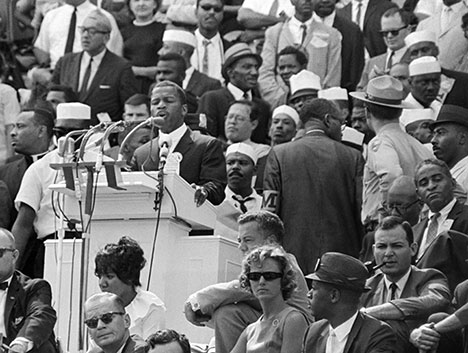 SNCC leader John Lewis speaking at
March on Washington, 28 August 1963. Shachtmanite leader
Bayard Rustin played key role in censoring Lewis’ speech,
eliminating references to “revolution” and criticism that the
Kennedy civil rights bill was “too little, too late.”
SNCC leader John Lewis speaking at
March on Washington, 28 August 1963. Shachtmanite leader
Bayard Rustin played key role in censoring Lewis’ speech,
eliminating references to “revolution” and criticism that the
Kennedy civil rights bill was “too little, too late.” (Photo: Danny Lyon/Magnum Photos)
The largest demonstration of the civil rights movement, the “March on Washington for Jobs and Freedom,” took place on 28 August 1963. Remembered by many for Martin Luther King’s “I Have a Dream” speech, it was a thoroughly co-opted affair. Malcolm X criticized it as the “Farce on Washington,” caustically describing the Kennedy White House telling the organizers “how to come, where to stop, what signs to carry, what song to sing, what speech they could make, and what speech they couldn’t make.”5
The social democrats played a key role in this blunting of black militancy. (The current organization of the heirs of Shachtman and Harrington, “Democratic Socialists of America,” boasts on its website that the initiator of the march and its main organizers, were members of the Socialist Party.) The March on Washington was originally planned by A. Philip Randolph, president of the Brotherhood of Sleeping Car Porters, as far back as 1941, as a means to pressure the Roosevelt government to extend civil and labor protections to black people North and South. The Communist Party abandoned its initial support of the march as part of backing the Roosevelt government during the imperialist Second World War. After the war – which the “democratic” U.S. fought with a Jim Crow army – Randolph revived his call for a march, but he was stymied year after year by the self-appointed “friends of the Negro” in the Democratic Party and the union bureaucracy.
In the context of the mass actions of the early 1960s, pressure for the march became irresistible. Then the operatives of the ruling class sprang into action to control it politically. Foremost among these controllers was Harrington’s Socialist Party “comrade,” Bayard Rustin, with Shachtman disciples Tom Kahn and Rachelle Horowitz busily backing him up. Speakers and speeches were strictly vetted by Rustin. Of course, he didn’t touch the conservative speech of anti-Communist NAACP head Roy Wilkins. Wilkins, a toxic FBI fink, had actually opposed the March on Washington; he frequently baited Rustin for being gay and from the podium even slyly red-baited radical black historian (and NAACP founder) W. E. B. Du Bois, who had died in Ghana the day before.6
But Rustin went after SNCC’s speech with a large scissor, cutting out its radical conclusions. Thus it was the Shachtmanites, forebears of today’s DSA, who carried out this notorious censorship, in order to please the Kennedy White House. The gutted text was read by John Lewis, who is today a Democratic congressman. Carefully managed by the Kennedys and their sycophants, the March on Washington came to nothing. The more than 250,000 demonstrators went home with no more than the promise of a watered-down civil rights bill. In May 1964, in order to get some Republican votes to break a filibuster by Southern Democrats, Humphrey et al. put forward a “compromise” bill which relied more on private court suits than on federal enforcement of rights to service in public accommodations (like lunch counters).
False Friends in Bloody Mississippi
A brazen episode in the campaign to undermine challenges to the racist U.S. political system occurred the following year. The target was the Mississippi Summer Project and the Mississippi Freedom Democratic Party (MFDP). It was, quite literally, a joint operation of the Shachtmanites, the Democratic Party, CIA “friends and associates” and the United Auto Workers bureaucracy. The most prominent operatives were Allard Lowenstein, Bayard Rustin and UAW lawyer Joseph Rauh.
Since the defeat of Reconstruction in 1876, the great majority of black people had no secure civil rights in the United States. Nowhere was this more evident than Mississippi in 1964, a state with a 50 percent black population, few black voters, and ubiquitous black poverty. SNCC leaders Bob Moses and James Forman developed a plan to lay siege to this bastion of racism. In an alliance with the Congress of Racial Equality (CORE), they mobilized thousands of black Mississippians and brought hundreds of volunteers from the North, to register voters, establish black schools and libraries, and integrate public facilities.
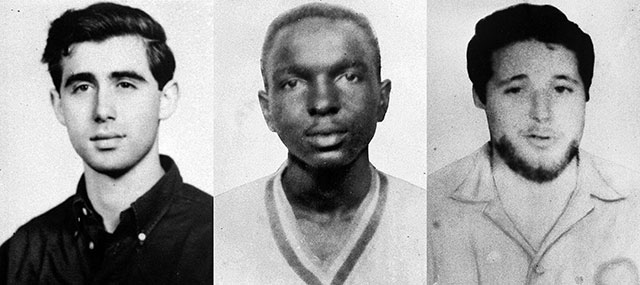
Andrew Goodman, James Chaney and Michael Schwerner, murdered by the Klan in Philadelphia, Mississippi in reign of KKK terror during “Freedom Summer” project of SNCC and CORE to register black voters.
(Photos: FBI / AP)
The main intention was to draw back the curtain on the savage repression black people experienced every day throughout the South – especially the nearly 1 million who lived in Mississippi. Many hundreds of civil rights activists were beaten and arrested that summer. On 21 June 1964, James Chaney, a black civil rights worker from Meridian, Mississippi, and Andrew Goodman and James Schwerner, white New York volunteers, were arrested by the police. In a coordinated action, after they were “released” from custody, they were murdered in the woods by the KKK. Partly because two of these heroic militants were white, a massive search was undertaken after they were reported missing. Their bodies were eventually found, but this search accidentally turned up the bodies of eight other black Mississippians, including a boy of 14! Their disappearance and murder had not even attracted attention. In fact, the KKK-police regime was on a rampage of terror in Mississippi.
When SNCC’s plan first became known to Lowenstein and Rustin, they set up their own operation to recruit volunteers, vetted by them, under the direction of future Democratic congressman Barney Frank. SNCC fought back and regained some control of recruiting, but plenty of selected volunteers were sent South.
At this same time, the Shachtmanites were also attempting a takeover of CORE. As he recounts in his autobiography, CORE leader James Farmer was able only with difficulty to expel the paid staffers Rustin forced on him: Norman Hill (a close associate of Harrington and Shachtman in Thomas’ Socialist Party), Hill’s wife Velma, her brother, and others. They took a salary from CORE, did no Civil Rights work, witch-hunted reds and schemed under Shachtman’s instructions to replace Farmer with Rustin.7 When the Socialist Party split after the 1972 elections, Rustin became the leader of Social Democrats, USA, the hard right-wing Cold Warriors (many directly tied to the CIA), a number of whom ended up in the administration of Ronald Reagan.
While Rustin never became the head of CORE, the organization was eventually flooded with Shachtmanites and succumbed to their Cold War machinations. (Farmer was later named an honorary chairman of the DSA.) In the 1970s under Roy Innis, CORE helped recruit CIA-backed mercenaries to fight with the forces of apartheid South Africa against the MPLA (Popular Movement for the Liberation of Angola) and its Cuban allies in Angola. The Rustin-led Shachtmanite SDUSA was allied with Innis and CORE in supporting the South African apartheid regime’s bloody war on Angola. Fortunately, the Angolans, with Cuba’s help, smashed these racists and imperialists, in one of the most inspiring moments of Africa’s anti-colonial history.
Fannie Lou Hamer and the Freedom Democrats
In 1963 and 1964, adherents of MLK-style pacifism were increasingly challenged politically by those advocating black self-defense, following the examples of Robert F. Williams, Malcolm X and groups like the Deacons for Defense in Louisiana. Reflecting on harsh experience, many black militants were lending an ear to Malcolm’s repeated warnings against having illusions in reforming the Democratic Party. Coming the year after the March on Washington, the coordinated campaign to undercut the Mississippi Freedom Democratic Party was one of the key episodes. While the MFDP showed the potential for independent political action, it was from the outset subordinated to the Democratic Party, a pillar of racist American capitalism, as was soon demonstrated.
Literally under the gun of racist terror and hamstrung by government infiltrators and witch-hunters, the Mississippi Summer Project of 1964 was unable to register many black voters in the official racist system. Nevertheless, it did organize unofficial black voting for the MFDP, which was founded that year in an effort to wrest the state’s Democratic Party structure away from the Dixiecrats. Sixty-four SNCC and CORE activists, all black but one, were designated as MFDP delegates and sent to the 1964 Democratic National Convention in Atlantic City, New Jersey. Their object was to gain credentials and be seated at the convention as the legitimate Mississippi delegation, on the grounds that the official delegation was a Jim Crow machine, selected through the violent exclusion of half of the state’s population.
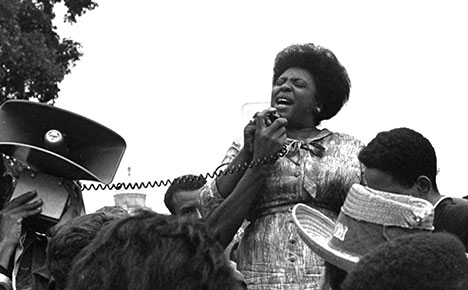 Fannie
Lou Hamer: “Sick and tired of being sick and tired.” A
sharecropper who started picking cotton at age 6, she was a
victim of involuntary sterilization and her family was evicted
by plantation owner when she tried to register to vote. Hamer
was the spokesperson for the Mississippi Freedom Democratic
Party at Democrats’ 1964 Atlantic City convention.
Fannie
Lou Hamer: “Sick and tired of being sick and tired.” A
sharecropper who started picking cotton at age 6, she was a
victim of involuntary sterilization and her family was evicted
by plantation owner when she tried to register to vote. Hamer
was the spokesperson for the Mississippi Freedom Democratic
Party at Democrats’ 1964 Atlantic City convention. (Photo: William J. Smith/AP)
The co-chair of the Freedom Democrats was a woman of legendary courage named Fannie Lou Hamer. She was a sharecropper from Sunflower County in the Mississippi Delta. In 1961, like many black women in the American South, she had been sterilized without her knowledge or consent. As she later testified, “I would say about six out of the ten Negro women that go to the hospital are sterilized with the tubes tied.” The experience drove her to join the civil rights movement and eventually to SNCC. In 1962 she attempted to register to vote. When plantation owner W. D. Marlow heard about this, he forced her off his land and seized all her family’s property. Undeterred by Marlow or by a KKK assassination attempt, Ms. Hamer continued her civil rights work. In 1963 she was arrested in Winona, Mississippi. While a captive, she was beaten at the command of the police: two large male prisoners struck her with blackjacks in turn until they were both exhausted. The beating caused permanent damage to Ms. Hamer’s eyes and kidneys.
At Atlantic City, Ms. Hamer gave riveting testimony before the Credentials Committee, telling of her attempts to register to vote and the horrors perpetrated upon her because of this. She noted the many recent racist murders in Mississippi, including the assassination of NAACP field secretary Medgar Evers, which occurred a few days after she was let out of jail. She concluded:
“All of this is on account of we want to register, to become first-class citizens. And if the Freedom Democratic Party is not seated now, I question America. Is this America, the land of the free and the home of the brave, where we have to sleep with our telephones off of the hooks because our lives be threatened daily, because we want to live as decent human beings, in America?”8
Her testimony was being televised nationally, but when Lyndon Johnson found out, he called an emergency press conference to distract the media and cut her off. Johnson and Humphrey then exerted pressure on supporters of the MFDP on the Credentials Committee and they fell into line. The Democrats would recognize only the official white racist delegation. The MFDP was offered two non-voting seats – on condition that neither seat would go to Fannie Lou Hamer. Humphrey explained, “The President has said he will not let that illiterate woman speak on the floor of the Democratic convention.”9
The MFDP delegates were defiant and refused to cooperate. Hamer’s answer was simply spoken: “We didn’t come all this way for no two seats.” The black delegates then sat in the unoccupied seats of the white delegation – which bolted the convention to back Barry Goldwater, the Republican candidate. So dependent on the support of the racist Dixiecrats was the party of LBJ, Rustin, and Reuther, however, that they refused to seat the black Mississippians even then, after the racist delegates had left for good.
In a squalid display of their subservience to the racist system, Rustin and Rauh tried to get SNCC and the MFDP to reconsider their refusal and accept the “compromise.” Forman, who was present at the meeting, transcribed Rustin’s haughty lecture to the Mississippians:
“[T]here is a difference between protest and politics. The former is based on morality and the latter is based on reality and compromise. If you are going to engage in politics, you must give up protest.... You must accept the compromise. If you don’t, then you are still protesting.
“We must think of our friends in labor, Walter Reuther and the others, who have gone to bat for us. If we reject this compromise, we would be saying to them that we didn’t want their help.”
One SNCC organized yelled, “You’re a traitor, Bayard, a traitor!” Veteran activist Ella Baker, who worked closely with SNCC, denounced Rauh as a mouthpiece for the white liberal establishment. At the same meeting, Moses and Forman heard one admonitory lecture after another from LBJ’s backers, including Martin Luther King. Meanwhile, Allard Lowenstein was taking notes of radical statements made by SNCC supporters, scribbling “heckling of Rustin,” “[Stokely] Carmichael’s talk ‘wild’,” as part of a list of those “to be ‘examined’.” This imperialist snitch was actually recording SNCC’s disillusionment with the Democratic Party. As one militant put it, “After Atlantic City our struggle was not for civil rights but for liberation.”10
What about DSA founder, Shachtman deputy and leading spokesman for the “realignment” strategy Michael Harrington? He “sided publicly with Rustin” (they were both in the SP) and then “urged MFDP supporters to put aside their bitter feelings.” The entire episode was widely seen by radicalizing youth, both black and white, as “proof of the bankruptcy of liberalism.”11
The Limits of a Movement
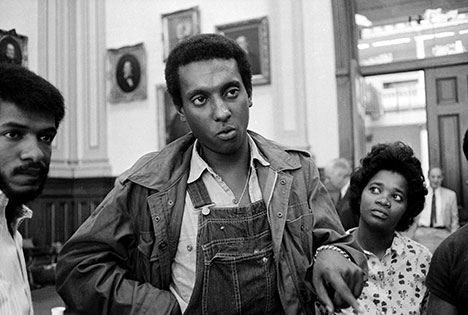 Stokely Carmichael, chairman of Student
Non-Violent Coordinating Committee, in Georgia legislature,
1966.
Stokely Carmichael, chairman of Student
Non-Violent Coordinating Committee, in Georgia legislature,
1966. (Photo: Bettmann Archives)
SNCC’s homegrown militancy was partly based on an illusion that Northern Democrats would help black people overturn racial oppression. This was not and could not have been true. The Democratic Party was and is a party of the racist status quo. It had been the party of Southern Secession and slavery; it was the party of the KKK and race terror during Reconstruction; it was the party of Jim Crow after Reconstruction’s defeat. When the Democrats made it to the White House again, their ultra-racist president, the reputed liberal Woodrow Wilson, scion of a pro-slavery, slave-owning Virginia family, fired every black civil service employee in Washington, while promoting the Klan propaganda film Birth of a Nation.
In the 1950s and 1960s the Democrats presided over a society, North and South, that was nearly completely segregated – de jure (by law) in the South, de facto in the North – in housing, schools, and employment. Today, despite civil rights laws and court decisions that are being steadily eroded, brutal segregation remains the norm and millions of black people are in prison, on parole, or branded as criminals by the system, whether it is ruled over by Obama or Trump. In American ruling-class mythology, Wilson, JFK and LBJ, as well as Clinton and Obama, are held up as enlightened rulers committed to freedom and democracy. They are compared to their great forefather, Thomas Jefferson. This is fitting in its way, since Jefferson was a slaveholder who as a politician worked to starve black Haiti and create a slaveholding empire across North America.
In the civil rights years Kennedy and Johnson yielded as little as they could, but yield they had to. They faced a determined black population that marched directly into ferocious repression, undeterred. From depraved white racists they endured beatings, torture, rape, mutilation, sterilization and uncounted murders, including of innumerable children. But they would not turn back. Living as they did in a modern capitalist state, black people themselves ripped up the maniacal racial laws and claimed their civil rights. The Civil Rights Act of 1964 and Voting Rights Act of 1965 simply acknowledged the faits accomplis, though with a fair amount of treacherous language. For its part, the white power structure in the South clawed back with strategies that characterize the entire country today: racist control of the social and political system, the creation of white “academies” and defunding of public education, the closing of public facilities, escalated policing of black neighborhoods, new laws targeting black people, mass incarceration.
When Martin Luther King marched in Chicago in 1966 against that Northern city’s brutal system of housing segregation, he was met by a racist mob thousands strong. Marchers were attacked and King himself was struck in the head with a rock. “I have seen many demonstrations in the South,” he said, “but I have never seen anything so hostile and so hateful as I’ve seen here today.” The truth is that the whole American capitalist system is founded on racial oppression, from New Orleans to New York and Los Angeles to Chicago. Reformist protests will never break its grip. Only a revolutionary program can bring black liberation and the liberation of all the oppressed. And this will take integrated revolutionary struggle relying on the social power of the multiracial working class.
Toward a Revolutionary Perspective
The SNCC militants learned hard lessons the hard way about the role of social democrats and labor bureaucrats in upholding the racist American establishment. They faced a stark choice: to find their way to a revolutionary position against the entire American capitalist ruling class or cave in to the corruption and lies of the likes of Harrington and Rustin, social-democratic servants of U.S. imperialism. Instead, because of the weakness of genuinely revolutionary forces, many turned to the dead end of black nationalism. The Communist Party, which had largely been driven underground in McCarthyite USA, sent many of its supporters into the South, but the CP had long ago debased the red banner of revolution in favor of reformist support to the Democratic Party.
At the time, in the early 1960s in the U.S, the program of revolutionary Marxism could have been represented only by the Trotskyists of the Socialist Workers Party (SWP). The SWP, however, fatally abdicated its responsibility to the struggle for black liberation – a struggle that is in its very essence connected to the very foundations of oppression and exploitation in the American capitalist system. Instead, on its rapid road toward reformism (and eventual irrelevance), the SWP told black people that they must go it alone; American Marxists would support them but take no leadership role.
The justification for this unpardonable abstentionism was found in a petty-bourgeois nationalist orientation. The majority in the SWP supported a line worked out by a party theoretician, George Breitman, which held that blacks must struggle and organize independently and not as part of a multi-racial revolutionary party. During the 1930s, the Communist Party had developed its “black belt” theory after Joseph Stalin abruptly decided that African Americans should be considered a nation. Despite the Great Migration that began in WWI (and would relocate six million black people to urban centers outside the South), this theory advocated for a separate black nation in the most rural, least developed parts of the U.S. South.
While the SWP was not necessarily calling for geographical separation in 1963, its line of separate black struggle was consonant with a nationalist trend developing among petty-bourgeois radicals in the black movement. Like Stokely Carmichael, these activists were searching for deeper answers to the psychosis of racist America, and were disillusioned with the liberal integrationism of King, Rustin and others who demanded “moderation.”
Carmichael’s political trajectory offers an interesting view into what might have been. He would eventually call for “black power”: while voicing a desire for militancy and a break from liberal accommodationism, it was an ambiguous slogan, some of whose adherents sought salvation in “black capitalism.” Carmichael himself would later move to Guinea, change his name to Kwame Ture and embrace Pan-Africanism. In 1963, however, the young SNCC activist was actually a member of the Socialist Party’s Young People’s Socialist League (YPSL). At the same time, he was a contact of the SWP’s youth group, the Young Socialist Alliance (YSA).
Radicalized after seeing first-hand the treachery of the “liberal-labor syndrome,” he would have good reason to wonder why he was in YPSL. Carmichael was contacted by adherents of a minority grouping within the SWP/YSA, which had a revolutionary Marxist position on the fight for black freedom quite different than the majority leaders’ abstentionism. This grouping, which became the Revolutionary Tendency (RT) and later the Spartacist League that for three decades was the voice of authentic Trotskyism, held that the racial oppression of African Americans cannot accurately be categorized as a national question; the idea of forming a separate nation was illusory; and that black liberation is central to socialist revolution by and for the whole working class. This position of revolutionary integrationism is upheld by the Internationalist Group today.
The theory was developed by Richard Fraser, an SWP cadre in the 1950s, and is based on his years of engaging in class struggles involving black and white workers. He wrote a document called “For the Materialist Conception of the Negro Question” (1955), which answered Breitman’s separatist line with a model history lesson on black struggles against racist exclusion from American society. He spoke of the role of the early Communist Party, following the principles laid down by Lenin and Trotsky, in inspiring interracial struggle against racist oppression. Fraser furthermore detailed the rise of the modern American industrial economy on the backs of millions of black workers. They created that wealth, he pointed out, and it is their birthright to claim it. This can only be accomplished through workers revolution to overthrow capitalism. Such a revolution can only be led by a multiracial revolutionary party.
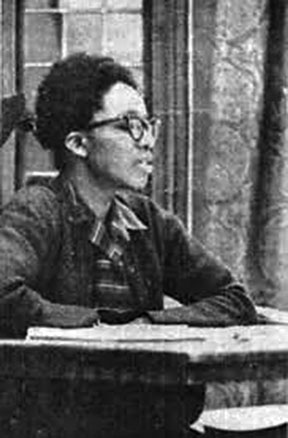 Shirley Stoute, in 1963,
when she was co-author with James Robertson of “For Black
Trotskyism.”
Shirley Stoute, in 1963,
when she was co-author with James Robertson of “For Black
Trotskyism.” James Forman, too, was seeking a revolutionary perspective at this time. He was so impressed with a member of the SWP minority that he asked her to join him for further organizing in the South. She was Shirley Stoute, co-author (with James Robertson) of a revolutionary-integrationist document called “For Black Trotskyism” (1963).12 She and other comrades of the RT were tragically prevented by the SWP majority from engaging in black recruitment at a time when people of the caliber of Carmichael and Forman were searching for revolutionary answers.
“For Black Trotskyism” begins with a point Leon Trotsky made during a discussion with SWP members in Coyoacán, Mexico a year before an assassin sent by Stalin killed the founder of the Fourth International. Referring to the U.S. black population, he stressed: “If ... we in the SWP are not able to find a road to this stratum, then we are not worthy at all. The permanent revolution and all the rest would be only a lie.” Trotsky was speaking in 1939, yet his message to American communists was the same as 20 years earlier, when both Lenin and Trotsky delivered it. The SWP’s abandonment of that perspective sabotaged the chance that leading militants of the early-1960s civil rights movement might have had to be won over to revolutionary Marxism. The task of winning over and cohering a core of black Trotskyist cadre remains unfinished. It must be carried out because without overthrowing racist U.S. capitalism once and for all, there can be no black liberation in racist America; and there can be no socialist revolution in the United States without a multiracial revolutionary workers party.
- 1. Richard Cummings,The Pied Piper: Allard K. Lowenstein and the Liberal Dream (Grove Press, 1985), p. 224. On “Lowenstein’s lengthy history of involvement” (as the author delicately calls it) “with groups and activities...shown to have CIA connections,” also see William H. Chafe, Never Stop Running: Allard Lowenstein and the Struggle to Save American Liberalism (Basic Books, 1993), pp. 104-107, 254-261.
- 2. James Forman, The Making of Black Revolutionaries (Open Hand, 1985), p. 357.
- 3.Forman, The Making of Black Revolutionaries, pp. 380-381.
- 4.Forman, The Making of Black Revolutionaries, pp. 220.
- 5. Malcolm X, “Message to the Grass Roots,” 10 November 1963, on line at http://thespeechsite.com/en/famous/MalcolmX-2.pdf.
- 6. See Bruce J. Dierenfield, The Civil Rights Movement, rev. ed. (Routledge, 2008), p. 87; and excerpt from Wilkins’ speech at http://www.beaconbroadside.com/broadside/2010/08/excerpt-roy-wilkinss-reluctant-tribute-to-web-du-bois.html.
- 7. James Farmer, Lay Bare the Heart (Arbor House, 1985), pp. 260–262.
- 8. The Speeches of Fannie Lou Hamer: To Tell It Like It Is (University Press of Mississippi, 2011), p. 45.
- 9. Quoted in “Fannie Lou Hamer,” Freedom Summer, American Experience website, pbs.org.
- 10. Forman,Making of Black Revolutionaries, 392; Cummings, Pied Piper, pp. 269-270; John Dittmer, Local People: The Struggle for Civil Rights in Mississippi (University of Illinois Press, 1994), p. 302.
- 11. Maurice Isserman,The Other American: The Life of Michael Harrington (Public Affairs, 2000), pp. 245-246.
- 12. This document was included in the SL’s Marxist Bulletin No. 5, What Strategy for Black Liberation? Trotskyism vs. Black Nationalism, originally published in 1978. This bulletin has been reprinted, along with the document “Black and Red - Class Struggle Road to Negro Freedom,” adopted by the SL’s founding conference in 1966, as part of the Internationalist Group’s series of class readings.
